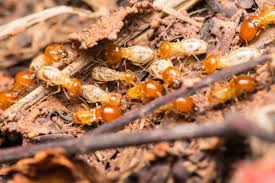The smart Trick of Termite Control Process That Nobody is Discussing
Spring time, particularly a hot, sunny day after rain, is the perfect time for underground termite swarming behaviour and, at least for short moments throughout the daytime, a chance to see live termites and perhaps a particular place where they're emerging from in the home. As most dirt around a house has buried cellulose debris (roots, stumps, or fence posts), finding swarming termites in your lawn doesnt necessarily mean that your house has termites. .

Building design may add to the likelihood of termite invasion. Identify and correct or promote termite infestations. Ideally all wood beneath the construction should be held at least 1 2 inches. Consult local building codes for exact distances from wood.
Keep base areas dry and well ventilated. By removing any wood in contact with the soil, reduce chances of infestation. Inspect porches and other structural or foundation wood for signs of termites. Start looking for tree stumps, stored fence posts, and buried scrap wood. .

The Buzz on Termite Control Products
Structural lumber in buildings is generally Douglas-fir, hemlock, or spruce. Whereas another two aren't of these substances, Douglas-fir is moderately resistant to termites. Lumber used in bases and other wood in contact with the soil must be treated or naturally resistant to termites and decay to help safeguard against damage in areas where building designs have to be concrete or altered can't be used.
However, subterranean termites may build their shelter tubes over chemically treated timber and infest stained timber above, if wood is utilized over the treated timber. .
Use just exterior-grade, pressure-treated timber for areas which are exposed to weather; differently, the chemical in the timber may leach from the wood. All topical remedies which will be exposed to weather should also have a sealer coat to prevent leaching into the soil after rain.
The smart Trick of Termite Control Process That Nobody is Talking About
Subterranean termites in constructions can't be controlled using techniques that are acceptable for drywood termites, such as fumigation, heat treatment, freezing, and termite electrocution apparatus, because the reproductives and a huge majority of these termites are concentrated in nests near or below ground level from reach of those control procedures.
To facilitate control of subterranean termites, destroy their shelter tubes whenever possible to disrupt access to wooden substructures. .
Liquid uses of pesticides applied in drenches either to the soil or by injection and are used for subterranean termite management. There aren't any reliable control products most of successful products are for professional use only.
Termite Control Procedure Fundamentals Explained
Management professionals have been provided special training due to the hazards involved in applying insecticides to the soil around and i was reading this under buildings. Applications in the wrong area can lead to contamination of heating ducts or damage to heat pipes or plumbing utilized for sewage or water beneath the treated construction.
Lately, active ingredients used to control subterranean termites in soils were broadly classified as repellent or nonrepellent. Repellent insecticides, generally pyrethroids can be detected by subterranean termites; without receiving and they're repelled. As a result of this reaction products comprising repellent active ingredients have been phased out. .

Subterranean termite baits, which are insecticides shared inside the colony and consumed during feeding, are available in California. Bait is delivered inside a cellulose or timber matrix installed around a construction and also infused with the active ingredient. Industrial bait products are available for above-ground usage, where there is no soil for station setup.
Some Known Details About Termite Control Procedure
IGRs have low toxicity to people and their pets. The best bait productsare offered for use. .
Haverty, M. I., R. L. Tabuchi, E. L. Vargo, D. L Cox, L. J. Nelson, and V. R. Lewis. 20 10. Response of Reticulitermes hesperus (Isoptera: Rhinotermitidae) colonies to find more info baiting with lufenuron from Northern California. J. Econ. Entomol. 10 3:7 70-7 80.